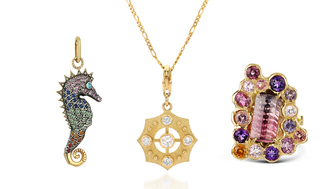As the shopping mall model evolves and online retail grows, Smith shares his predictions for the future of physical stores.
Squirrel Spotting: 10 Random Sales Tips for the Season
Smile, Peter Smith says, and stay away from chronically negative people.

As we approach the critical holiday season, I thought it might be fun to share a few random tips that you might want to think about on the sales floor.
Have fun and be great!
1. Smile
Smiling engages the mirror neurons in our customers. They don’t care about our motivations, they’re just happy to see a warm smile, and they are more likely to reciprocate and adopt a more positive and friendly attitude as a result.
2. Use Hand Gestures
Effective communicators tend to use their hands more when they are speaking. It makes you appear warmer and more relatable. Let your hands help with your communication.
3. Avoid Negative People
There is no value whatsoever in choosing to associate with chronically negative people.
We all need to vent occasionally, but some people seem to have been born to complain and they must be avoided at all costs. You can’t be successful in sales unless you bring a positive attitude to work and maintain it throughout the day.
4. Don’t Information Dump
Great salespeople are not information-dumpers. They don’t use customer interactions as an opportunity to spew every fact and feature of their products. It is important to know your products well enough to speak to them, but the goal is to connect on an emotional level.
5. Be Authentic
Always present an authentic version of yourself to your customers. There are so many elements that contribute to our communication, verbal and non-verbal, so trying to present an inauthentic version of yourself will be taxing for you, and not terribly convincing for your customers.
6. Features and Benefits Are Irrelevant Until We Connect Emotionally
Features and benefits mean absolutely nothing unless you connect with your customer on an emotional level. Once that has been accomplished, you can underscore the connection with select features and their respective benefits to your customer.
7. Set Goals for Yourself
Having goals is like a GPS system for your own performance. The most obvious example is a daily/ weekly/monthly sales goal. But there are other measures to drive your own performance.
What is your average sale? Can you improve your personal conversion rate? Can you make X amount of add-on sales? If you work for a store that does not provide goals, set them yourself.
8. Use Your Colleagues
Using your colleagues to help shows them respect and demonstrates humility and curiosity on your part.
9. Sell Value, Not Price
Value and price are separate but often confused terms.
If I buy something for the cheapest price and it breaks or underperforms, did I get a good value? If I pay “more” for something than I might have wished, and it performs beautifully for years, did I pay too much?
Establishing value requires the salesperson to understand the underlying motivations behind a customer’s questions and to probe beneath the surface of requests for cheap prices and discounts. Do the work and sell the customer something she or he won’t regret buying. That’s value.
10. Build Your Customer Base
The difference between good and great salespeople is that good salespeople get a solid share of walk-ins, while great salespeople get a solid share of walk-ins and drive their own customers.
Every interaction is an opportunity to build your customer base. Don’t waste that opportunity during the holidays when you have more customers to work with. Capture key information and follow up after the season. These are the seeds of next year’s business.
Have a great season!
Peter Smith is president of Vibhor, a public speaker and author of “Sell Something” and “Hiring Squirrels.” He spent 30 years building sales teams in retail and wholesale and he can be contacted at dublinsmith@yahoo.com, peter@vibhorgems.com, or on LinkedIn, Facebook or Twitter.
The Latest

The trade show is slated for Jan. 31-Feb. 2 at The Lighthouse in New York City's Chelsea neighborhood.

January’s birthstone comes in a rainbow of colors, from the traditional red to orange, purple, and green.

How Jewelers of America’s 20 Under 40 are leading to ensure a brighter future for the jewelry industry.

The annual report highlights how it supported communities in areas where natural diamonds are mined, crafted, and sold.


Footage of a fight breaking out in the NYC Diamond District was viewed millions of times on Instagram and Facebook.

The supplier has a curated list of must-have tools for jewelers doing in-house custom work this year.

Roseco’s 704-page catalog showcases new lab-grown diamonds, findings, tools & more—available in print or interactive digital editions.

The Signet Jewelers-owned store, which turned 100 last year, calls its new concept stores “The Edit.”

Linda Coutu is rejoining the precious metals provider as its director of sales.

The governing board welcomed two new members, Claire Scragg and Susan Eisen.

Sparkle with festive diamond jewelry as we celebrate the beginning of 2026.

In its annual report, Pinterest noted an increase in searches for brooches, heirloom jewelry, and ‘80s luxury.

Executive Chairman Richard Baker will take over the role as rumors swirl that a bankruptcy filing is imminent for the troubled retailer.

Mohr had just retired in June after more than two decades as Couture’s retailer liaison.

Shekhar Shah of Real Gems Inc. will serve as president of the Indian Diamond & Colorstone Association in 2026.

This year’s good luck charm features the mythical horse Pegasus, and is our first Piece of the Week of the new year.

Articles about crime, engagement rings, and a necklace worn in the World Series generated the most interest among readers.

As part of the leadership transition, Sherry Smith will take on the role of vice president of coaching strategy and development.

It marks the third time the country has headed the Kimberley Process. Ghana will serve as vice chair.

The new Bulova x Stetson designs highlight two animals often associated with the American West—the bison and the Texas Longhorn.

Its residency at Yamron Jewelers will run through May 2026.

The retailer is expanding into areas with large Indian and South Asian populations.

The Italian brand has opened its first flagship amid the peaks of the Dolomites in Madonna di Campiglio, Italy.

The new curation at the Natural History Museum of Los Angeles County showcases rare gem and mineral specimens in their uncut, natural state.

The couple pleaded guilty to concealing at least $127 million in cash transactions at its precious metals businesses.

Consumers shared concerns about prices, inflation, tariffs, trade, and politics in the survey’s write-in response section.



























